Given n non-negative integers representing an elevation map where the width of each bar is 1, compute how much water it can trap after raining.
Example 1:

Input: height = [0,1,0,2,1,0,1,3,2,1,2,1] Output: 6 Explanation: The above elevation map (black section) is represented by array [0,1,0,2,1,0,1,3,2,1,2,1]. In this case, 6 units of rain water (blue section) are being trapped.
Example 2:
Input: height = [4,2,0,3,2,5] Output: 9
Solution 1(Optimal approach):
Space complexity: O(1), Time complexity: O(n)
class Solution {
public int trap(int[] height) {
if(height.length==1 || height.length==2)
return 0;
int n=height.length;
int maxLeft=height[0],maxRight=height[n-1];
int trappedWater=0;
int leftptr=1,rightptr=n-2;
while(leftptr<=rightptr){
int min=0,diff=0;
if(height[leftptr]>maxLeft)
maxLeft=height[leftptr];
if(height[rightptr]>maxRight)
maxRight=height[rightptr];
if(maxLeft<=maxRight)
{
min=Math.min(maxLeft,maxRight);
diff=min-height[leftptr];
leftptr++;
}else
{
min=Math.min(maxLeft,maxRight);
diff=min-height[rightptr];
rightptr--;
}
trappedWater=trappedWater+diff;
}
return trappedWater;
}
}
Solution 2: (Space complexity: O(n), Time complexity: O(n))
class Solution {
public int trap(int[] height) {
if(height.length==1 || height.length==2)
return 0;
int n=height.length;
int maxLeft[]=new int[n],maxRight[]=new int[n];
int trappedWater=0;
int leftMax=0,rightMax=0;
for(int i=0;i<n;i++){
if(height[i]>leftMax)
leftMax=height[i];
maxLeft[i]=leftMax;
}
for(int i=n-1;i>=0;i--){
if(height[i]>rightMax)
rightMax=height[i];
maxRight[i]=rightMax;
}
for(int i=1;i<n-1;i++){
int min=Math.min(maxRight[i],maxLeft[i]);
int diff=min-height[i];
trappedWater=trappedWater+diff;
}
return trappedWater;
}
}
No comments:
Post a Comment